Częstochowa- Silesian 作者: 来源: 发布时间:2021-05-19
Ⅰ. Population and Area
Population (31 December 2019)
• City 220,433 Decrease (13th)
Area
• City 160 km2 (60 sq mi)
Website
http://www.czestochowa.pl/
Ⅱ.Natural Geography
Częstochowa is situated in the Upper Warta River Valley in South-Central Poland, on the borders of three geographic macro regions: the KrakowCzęstochowa Highlands, Silesian Highlands and the Mid-Poland Lowland. Historically, it belongs to Western Lesser Poland (Małopolska), but as a result of the 1999 administrative reform it was included in the Silesian Province.
Transport
Main road connections from Częstochowa include a connection with Warsaw (to the north-east) and Katowice (to the south) via the European route E75 (Motorway DK1-PL.svg). There are also three other national roads: DK43-PL.svg to Wieluń, DK46-PL.svg to Opole and DK91-PL.svg to Piotrków Trybunalski. Furthermore, Częstochowa is a major railroad hub, located at the intersection of two important lines - west-east (from Lubliniec to Kielce) and north-south (from Warsaw to Katowice). Also, an additional northbound line stems from Częstochowa, which goes to Chorzew Siemkowice, where it joins the Polish Coal Trunk-Line. There are six railway stations in the city, the biggest ones being Częstochowa Osobowa and Częstochowa Stradom. The city has direct connections to many Polish cities as Warsaw, Cracow, Katowice, Wrocław and Szczecin, proteza koniecpolska makes some of the connections more comfortable.
The public transport is managed by the Częstochowa City Council of Roads and Transport. The public transport carriage is contracted to the City Public Transport Corporation (Miejskie Przedsiębiorstwo Komunikacyjne). The public transport in Częstochowa comprises 3 tram lines, 30 city bus lines and 8 suburban lines connecting Częstochowa with Blachownia, Mstów, Konopiska, Poczesna, Olsztyn. The bus transport connecting Częstochowa Bus Station with other towns and villages in the Częstochowa region is operated by the Częstochowa Bus Transport Ltd. (PKS Częstochowa).
The closest airport is the Katowice International Airport, which is located 60 km (37 mi) from Częstochowa, and a small Częstochowa - Rudniki airport in Kościelec, Rędziny.
Ⅲ.Economy
-Structure of business entities
-There are 26 725 registered business entities in Częstochowa. The public sector is comprised of 573 entities that can be divided as follows:
-• budgetary law entities owned by the state or by local governments – 272
-• state-owned companies – 1
-• commercial companies – 27
-• joint ventures – 1
-The private sector constitutes an overwhelming majority of businesses and comprises 26,152 entities in the following categories:
-• sole proprietorships - 20 737
-• commercial companies - 2 184
-• joint ventures - 406
-• cooperatives – 77
-• foundations - 76
-• associations and social organisations -587
-doing_business_1.pdf http://en.czestochowa.pl/data/other/doing_business_1.pdf
-Presents an employment structure in Częstochowa at the end of 2009 broken into economic sectors.
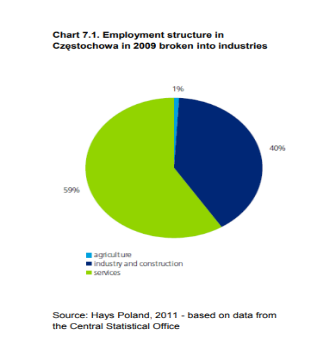
-The chart clearly demonstrates that the poviat is urban by nature; a little more than 1% of population works in a farming sector. Manufacturing industry employs approximately 40% of population which is a considerable result in comparison with other Polish cities of a similar size. ISD Częstochowa Steelworks has been the biggest employer in this sector, providing workplace to approx. 4500 people
-which constitutes 14,5% of total number of employed in a manufacturing industry. Another large company in the sector is TRW Automotive, which runs their production facilities of airbags and safety belts in Częstochowa. Apart from the factories employing 2500 people, the company has also set up a European Finance Centre in order to manage key financial operations and accounting procedures of TRW establishments in Europe. In 2011 the Centre employed 150 accountants with a knowledge of German, French, English and Czech. The company has also established in Częstochowa its Research & Development Facility, employing highly qualified engineers of various specialities. 59% of people or more than 45 500 individuals were employed in trade and services in 2009. The number increased by 9,8% in comparison to 2005. The change of economic structure in Częstochowa over the last 5 years is noticeable: in 2005 the service sector employed 56% of working population. The increase of this number by 3 percentage points over the last 5 years proves that the economy in Częstochowa follows the general trend of service economy; however, it is still heavily reliant on a manufacturing industry. The service sector is largely based on SMEs.
-doing_business_1.pdf http://en.czestochowa.pl/data/other/doing_business_1.pdf
-Mar 22, 2019 · In Częstochowa, Poland economy, Finance Manager is on the top list of highest earners, earning an average gross salary of PLN 180,000. Logistics Administration and Event Organizer follow, earning PLN 85,000 and PLN 67,000, respectively.
-https://www.averagesalarysurvey.com/cz%c4%99stochowa-poland
Ⅳ.Industrial Characteristics
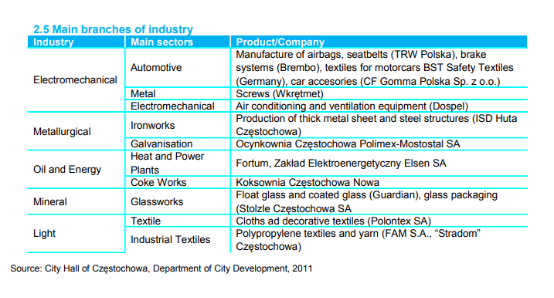
-Main Branches of industry
-Electromechanical,Metallurgical,Oil and Energy,Mineral,Light
-Economic activities are focused mainly on the following industries (numbers of entities operating in a given industry indicated in brackets):
-• Manufacturing (9750)
-• Construction (2464)
-• Wholesale and retail sale; repair of vehicles (8478)
-• Transportation and storage (1405)
-• Accommodation and food service activities (629)
-• Financial and insurance activities (1062)
-• Real estate activities (1071)
-• Professional, scientific and technical activities (2305)
-• Arts, entertainment and recreation activities (429)
-• Other service activities (1573)
-Key Projects
-1. Section of Poland’s A1 motorway between Częstochowa and Pyrzowice under construction
-A section of the A1 motorway in Poland’s Silesia region is under construction between the city of Częstochowa and the village of Pyrzowice, close to Katowice international airport. The new stretch of road, a dual carriageway with two lanes running in each direction, is approximately 58 km in length.
-Section of Poland’s A1 motorway between Częstochowa and Pyrzowice under construction-Projects - Regional Policy - European Commission https://ec.europa.eu/regional_policy/en/projects/poland/section-of-polands-a1-motorway-between-czestochowa-and-pyrzowice-under-construction
-2. Częstochowa Celebrates Its 800th Anniversary
-As part of the anniversary celebrations, there will be an upgrade to the Stary Rynek which, prior to World War II, was a centre of Jewish communal and commercial activity.
-https://www.czestochowajews.org/latest-news/
Ⅴ.Attrations and Cityscape
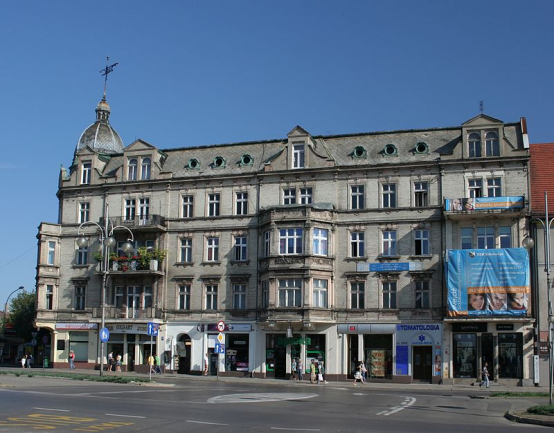
Franke's House
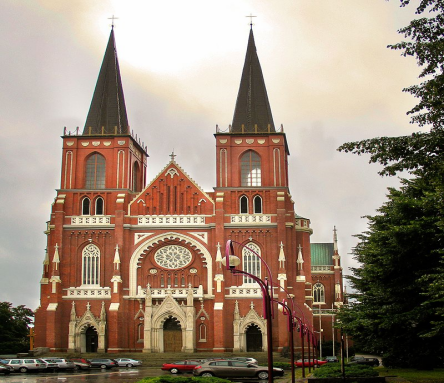
Basilica of the Holy Family
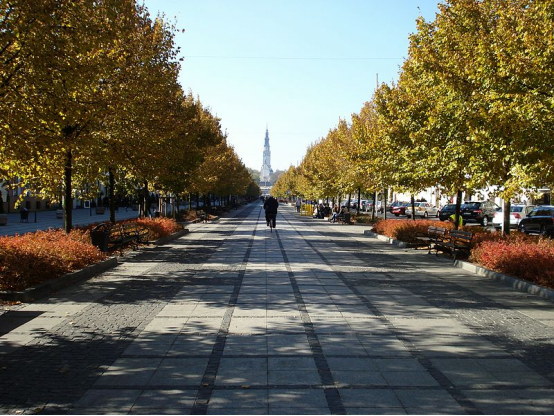
Maryi Panny Avenue
-The main representative artery in the city centre is the Najświętszej Maryi Panny Avenue (The Holy Virgin Mary Avenue). It was first built in the beginning of the 19th century, as a road linking Częstochowa with New Częstochowa, cities which were administratively merged in 1826. The most characteristic feature of the avenue is its layout, whereby the lanes are separated by the pedestrianised boulevard. During the pilgrimage period, the Avenues are used by pilgrims heading for Jasna Góra Monastery. The avenues are 1.5 km long and 44 m wide; primarily they perform trade, service, financial and cultural functions. The housing consists mostly of classicist, late-classicist houses, rarely eclectic. More modern buildings can also be noticed. The most interesting townhouses include:
-Franke's House
-Franke's House – in the beginning, it belonged to Adolf Franke, a Lutheran hailing from Greater Poland and also an owner of a spinning mill and textile mill. It was being built between 1901 and 1903. Between 1918 and 1939, Hotel 'Victoria' was located there. During World War II, it lay on the border of the Jewish ghetto, which made it the key point for those wanting to escape. After the dismantling of the ghetto, the Franke's House housed German hospital and army hotel, and after the war, it was the seat of the High School of Arts and a bursary. Eclectic with prevailing neo-renaissance features.
-Basilica of the Holy Family
-Zapalkiewicz's House is classicist townhouse, built in 1871. It was the seat of a theatre, which was functioning until 1908. Later, until 1923, there was a cinema "Paryskie" and subsequently, a number of financial institution have had their branches in the building.
-Mercantile Townhouse – eclectic townhouse, was being built between 1894 and 1907. At the beginning business and economics courses were taking place there. Before the World War 2, it was the seat of Warsaw Industrial Bank and Częstochowa Savings and Loans Bank.
-Kohn's House is a neo-classicist townhouse, built in 1865. Before the war, a number of enterprises were operating in the building, including Bankers, Jackowski's Restaurant and Cafe, and Bata's Shoe Shop and between 1909 and 1930 a cinema called "Odeon".
-Polish Bank's Townhouse is an art nouveau townhouse, built in 1904. In the beginning, it was the seat of a local branch of the Russian State Bank. In 1927, the building was taken over by the Polish Bank Inc. After World War II, it became the property of the Polish National Bank. In 1990, the building was sold to the ING Silesian Bank.
-Biegański's House is a one-storey classicist townhouse built in 1880. Initially, it was owned by Karol Henryk Rosenfeld and later by his son-in-law dr. Władysław Biegański. After the Second World War, the building was a seat of the Częstochowa's Doctors Association.
-Hantke's Palace is an example of Baroque Revival architecture, built to the order of an industrialist and entrepreneur Bernard Hantke, who established the ISD Częstochowa Steel Mill. The palace was built between 1900 and 1903. After WW2, the building was the seat of the Częstochowa Steel Mill Culture Centre.
-Former Orthodox Vicarage – classicist townhouse, built in 1875, until 1918 it was the seat of a local Orthodox priest. In 1918, it was taken over by the local Catholic diocese. After the war, there was a local headquarters of the Polish Army. Since the 1970s it has been a property of the Częstochowa Regional Museum.
-Old Square – a square located in the Old Town district with dimensions of 100m by 66m. Since medieval times it operated as the main square of Old Częstochowa. There are still preserved old townhouses, which are listed on the historic monuments register. Between the 15th century and 1812, a town hall was located there, which was then damaged because of a fire. In 2007, archaeological works began. As a result, a city well was found and also fundaments of city facilities such as a weigh house and gallows.
-Wieluńska Street – one of the historic streets in Częstochowa, located in the vicinity of Jasna Góra monastery. It is 300 meters long and the buildings on the street were erected in the late-classicist style in the second half of the 19th century.
-Jasna Góra Parks are two city parks (Stanisław Staszic Park and 3 May Park) located in the city centre, on the slope of Jasna Góra Hill. The parks were established in 1843. The total area of both parks is 11.8 ha. The parks are a popular leisure place and a spot for those enjoying short walks. In 1909, the Great Exhibition of Agriculture and Industry took place in the park, it was attended by 660 exhibitors and 500,000 visitors. In Staszic Park, one can find an astronomical observatory, which was opened in 1909. The parks also accommodate the Iron Ore Museum.
-Ulica 7 Kamienic (7 Townhouses Street) is one of the historical streets in Częstochowa. It is 600 metres long; the street was created in the first half of the 19th century. The name derives from the seven houses which had been built at the beginning.
-Cathedral Basilica of the Holy Family, Częstochowa – a cathedral built in the neo-gothic style between 1901–1927. In 1925, it became a cathedral of a Roman Catholic Diocese of Częstochowa and in 1992 it became the basilica of the Roman Catholic Archdiocese of Częstochowa.
-St James' Church – built between 1869 and 1872 under the initiative of a Tsar's representative for Częstochowa region – Parmen Kashernikov. Initially, it was a seat of an Orthodox parish of Saints Cyril and Methodius. In 1914, it became a property of a Catholic church, serving as an army parish church. After the end of First World War, it was retained by the Catholic church as part of the Recovery of Orthodox Churches in the Second Polish Republic. In 1937, the Archdiocese of Częstochowa established a parish of St James.
-St Sigismund's Church – a gothic church built in the 15th century, making it the oldest parish church in Częstochowa.
-St Barbara's Church – built in the 16th century under the initiative of Father Andrzej Gołdonowski from the Pauline Order. The place is linked to the icon of the Black Madonna of Częstochowa. Following the desecration of the icon by robbers in 1430 who left it at a spring next to the current location of the church.
Ⅵ.History and Culture
-There was a settlement over the river Warta, on the trails between Malopolska, Silesia and Wielkopolska. This settlement has been promoted to a range of city through the decision of king Casimir The Great. The breakthrough decision of prince Wladyslaw Opolczyk located the monastery of Paulins and entrusted them with the Holy Icon. Six centuries ago, the town was taken into the Mother of God’s care.
-Since then, many rulers and peasantry, knighthood and rural people have been going on pilgrimages to Her Throne, the Throne of Queen of Poland. Thanks to them, Czestochowa became known to the whole world.
-During the 19th century, Czestochowa was the most developed city in this region of the country. New factories, houses, schools emerged instantly. Many of city skylines were e.g. steeple tower of the protestant church, the dome of orthodox church and moresque ornaments of the synagogue.
-Czestochowa was the first city to offer an honorary citizenship to Pope John Paul II. It was also the first one in Mid-East Europe to have been rewarded with Honorary Flag, Honorary Chart, and last but not least, Reward of the Council of Europe.
-Czestochowa is a significant academic center. Thousands of youths gain education to become highly-trained professionals. Small and medium businesses develop all the time. Local firms modernize their equipment, being better adjusted to competition on european and world markets. The city constantly builds newest infrastructure, investing more and more in ecology.
-We are proud to possess a great cultural makers’ environment and national legacy located in and around of Czestochowa. We are also proud of our compatriots, scattered throughout the world, who have come lately for the 1st World Czestochowa Compatriots Convention.
-The city is surrounded with picturesque, rocky hills, divided by the rivers’ valleys, combined into jura landscapes – with the dominating spire of Jasna Gora over it
Ⅶ.Other Information
-Częstochowa, city, Śląskie województwo (province), south-central Poland. The city originally consisted of two settlements—Old Częstochowa, founded in the 13th century, and Jasna Góra (Polish: “Shining Mountain”), founded in the 14th—which were merged in 1826. Roman Catholic pilgrimages are made to the Jasna Góra monastery (1382), which contains valuable frescoes and the famous painting Our Lady of Częstochowa (also known as The Black Madonna). The monastery was fortified and became a stronghold for Polish forces during the Swedish invasions of 1655 and 1705.
Ⅷ.Contact Information
-Mayor Krzysztof Matyjaszczyk (SLD)
-City Hall of Czestochowa
-Śląska 11/13 Street, 42-217 Czestochowa
-phone: +48 34 370 71 00; fax: +48 34 370 71 70
-VAT identification number of the City Hall: 573 011 53 04
-National Official Business Register REGON of the City Hall: 000515738
-VAT identification number of the Municipality of the City of Czestochowa: 573 274 58 83
-National Official Business Register REGON of the Municipality of the City of Czestochowa: 151399002
-email: info@czestochowa.um.gov.pl
-website: www.czestochowa.pl
